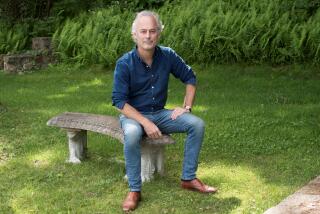Book review: ‘Autobiography of Mark Twain: Volume 1’
Autobiography of Mark Twain
Volume 1
Edited by Harriet Elinor Smith, et al.
University of California Press: 738 pp., $34.95
Having created a quintessentially American brand of humor and style of literature, Mark Twain (1835-1910) can now add to his myriad accomplishments the title of America’s first blogger. No matter that the “Autobiography of Mark Twain,” edited by a team led by Harriet Elinor Smith, weighs in at more than 5,000 pages. Volume One, covering the period from 1870 to 1906, and clocking in at a bit over 700 pages (including 200 pages of notes), is being published to coincide with Twain’s 175th birthday, Nov. 30.
But what a blog it is: A prose paean to Twain’s enormous energy level, his incessant need to express himself, and, on a parallel track, his unwavering narcissism. He rejected traditional means of orderly exposition in favor of creating a freewheeling record of his thoughts, unrestrained and unfiltered except by the King — himself.
No American author has ever captured the imagination the way that Twain did and continues to do a century after his death at 74. (Average life expectancy for men at the time was 47.) He was the first American global celebrity, with his signature claiming a higher price than President Roosevelt’s (to Twain’s delight, since he did not much care for Teddy). His great accomplishment in creating a distinct American sense of self and attitude is well described by Charles Kuralt: “If I had to say as much about America as I possibly could in only two words, I would say these two words: ‘Huck Finn.’”
Composing his mammoth “Autobiography” took Twain, on and off, more than 35 years of a life that included much satisfying success as well as devastating losses. He started writing installments the same year he married Olivia Langdon, in 1870, when he was 35. His first effort described the land investment his father had made, a purchase that weighed upon Twain like a millstone due to the annual taxes he had to pay after his father’s death. (In an ironic twist, after the land was sold, oil was discovered there.) While sustaining such a self-focus over such a long time would be an improbable passion for most mere mortals, Twain, despite his extremely modest beginnings in Florida, Mo., was not a humble guy. Indeed, he deemed his accomplishments so numerous and spectacular that by the end of his life he found the best analogy was comparing himself with Halley’s Comet: “The Almighty has said, no doubt: ‘Now here are these two unaccountable freaks; they came in together, they must go out together.’”
Never one to rest for any prolonged period of time, by the time of his death, Twain had managed to cross the Atlantic 29 times, completed an around-the-world lecture tour at age 59, written more than 50,000 letters, scores of short stories, some 3,000 newspaper and magazine articles and more than 30 books.
Twain’s “Autobiography” offers a mélange of childhood reminisces, vitriolic diatribes, portraits of individuals admired and despised, eulogies (most movingly of his daughters Susy and Jean), political and religious exegesis and, everywhere, evidence of his astonishing, lightning-quick wit. We learn what emotionally moved him: his elegy of his youngest daughter, Jean, is heartbreaking in its expressed anguish; what angered him: Countess Massiglia apparently was the most corrupt and evil landlady in history; and of his delight with the eccentricities of language, in particular the beauties and beasts of German.
The compositional method was one he had honed throughout his adult life and had practiced for decades before thousands on five continents: He simply talked. Twain is popularly regarded as the finest stand-up comedian ever and here was his opportunity to combine his talent at entertaining an audience with the establishment of his literary and personal legacy.
With the aid of Isabel Van Kleek Lyon, his private secretary, and various stenographers, Twain used his voice to re-create his past and to give shape to the way he would be remembered in the future. While he certainly intended that the autobiography would document what was, he also realized it was a vehicle for him to shape future generations’ perceptions of him. To that end he declared that the full “Autobiography” could not be published until a century after his death. Twain unsentimentally regarded his demise as “the refuge, the solace, the best and kindliest and most prized friend and benefactor of the erring, the forsaken, the old and weary and broken of heart.”
In making this arrangement, Twain added another extraordinary achievement to his already very full basket: He has become the only writer in history to have a new work come out a hundred years after passing away. This is not to say that this is the first time the “Autobiography” has seen the light of day. Indeed, 95% of “Volume 1” has been previously published in a number of other editions that were published after Twain’s death and with only one exception, they all violated his dictate that entries not be chronologically organized or divided into groupings. The only edition true to Twain’s wishes was scholar Michael Kiskis’ 1990 “Mark Twain’s Own Autobiography: The Chapters from the North American Review.” The bulk of the previously unpublished material will be available in Smith’s volumes 2 and 3, to appear over the next five years, resulting in approximately half of the contents of the original reaching the public for the first time.
In the “Autobiography,” Twain generously provides the 21st century aficionado a marvelous read. His crystalline humor and expansive range are a continuous source of delight and awe. What about the accuracy of his accounts? The proto-blogger was forming his world, what he thought his existence and accomplishments should be, not necessarily what objective observers might detail as actually having taken place. Indeed, Twain deliberately tweaked his earnest audience members who desired the truth: “I have not professionally dealt in truth. Many when they come to die have spent all the truth that was in them, and enter the next world as paupers. I have saved up enough to make an astonishment there.”
This was his version of reality, and what an entertaining record it is. Twain has given us “an astonishment” in his autobiography with his final, beautifully unorganized genius and intemperate thoughts. Pull up a chair and revel.
Trombley is president of Pitzer College and the author of “Mark Twain’s Other Woman: The Hidden Story of His Final Years.”
More to Read
The biggest entertainment stories
Get our big stories about Hollywood, film, television, music, arts, culture and more right in your inbox as soon as they publish.
You may occasionally receive promotional content from the Los Angeles Times.










